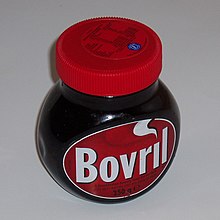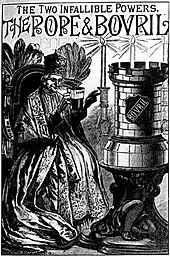Bovril
 Bovril (250 g jar) | |
| Inventor | John Lawson Johnston |
|---|---|
| Inception | 1889 |
| Manufacturer | Bovril Company |
| Current supplier | Unilever |
Bovrilis the trademarked name of a thick and saltymeat extractpaste, similar to ayeast extract,developed in the 1870s byJohn Lawson Johnston.It is sold in a distinctive bulbous jar and as cubes and granules. Bovril is owned and distributed byUnileverUK. Its appearance is similar to the BritishMarmiteand its Australian equivalentVegemite;however, unlike these products, Bovril is not vegetarian.
Bovril can be made into a drink (referred to in the UK as a "beef tea") by diluting with hot water or, less commonly, with milk.[1]It can be used as a flavouring for soups, broth, stews or porridge, or as a spread, especially on toast in a similar fashion to Marmite and Vegemite.[2]
Etymology[edit]

The first part of the product's name comes fromLatinbovīnus,meaning "ox".[3]Johnston took the-vrilsuffix fromEdward Bulwer-Lytton's then-popular novel,The Coming Race(1871), the plot of which revolves around a superior race of people, the Vril-ya, who derive their powers from an electromagnetic substance named "Vril". Therefore, Bovril indicates great strength obtained from an ox.[4]
History[edit]

In 1870, in theFranco-Prussian War,Napoleon IIIordered one million cans of beef to feed his troops.[5]The task of providing this went to John Lawson Johnston, a Scottish butcher living in Canada.[5]Large quantities of beef were available across the British Dominions and South America, but transport and storage were problematic. Therefore, Johnston created a product known as 'Johnston's Fluid Beef', later called Bovril, to meet Napoleon's needs.[6]By 1888, over 3,000UKpublic houses,grocers anddispensing chemistswere selling Bovril. In 1889, Bovril Ltd was formed to develop Johnston's business further.[7]
During the 1900Siege of Ladysmithin theSecond Boer War,a Bovril-like paste was produced from horsemeat within the garrison. NicknamedChevril(a portmanteau ofcheval,French forhorse,and Bovril) it was made byboiling downhorse ormulemeat to a jelly and serving it as a beef tea-like mixture.[8][9]Bovril also produced concentrated,pemmican-like dried beef as part of theBritish Armyemergencyfield rationduring the war. The ration came in the form of a pocket-sized tin can that contained the beef on one half alongside a driedcocoa drinkon another half. The dried beef could be eaten alone, or mixed with water to create a beef tea.[10]
Bovril continued to function as a "war food" inWorld War Iand was frequently mentioned in the 1930 accountNot So Quiet: Stepdaughters of WarbyHelen Zenna Smith.It describes the drink being prepared for the casualties atMonswhere "the orderlies were just beginning to make Bovril for the wounded, when the bearers and ambulance wagons were shelled as they were bringing the wounded into the hospital".[11]
When John Lawson Johnston died, his sonGeorge Lawson Johnstoninherited and took over the Bovril business. In 1929, George Lawson Johnston was madeBaron Luke,of Pavenham, in the county of Bedford.
Bovril's instant beef stock was launched in 1966 and its "King of Beef" range of instant flavours for stews, casseroles and gravy in 1971.[citation needed]In 1971,James Goldsmith'sCavenham Foodsacquired the Bovril Company but then sold most of its dairies andSouth Americanoperations to finance further take-overs.[12]The brand is now owned by the Anglo-Dutch multinationalUnilever,which bought Bovril in 2001.[6]
In 2004, Unilever removed beef ingredients from the Bovril formula, rendering it vegetarian. This was mainly due to concerns about decreasing sales, particularly from exports due to an export ban on British beef, as a result of the growing popularity ofvegetarianism,religious dietary requirements, and public concerns aboutbovine spongiform encephalopathy.[13]In 2006, Unilever reversed that decision and reintroduced beef ingredients to their Bovril formula once sales increased and the beef export bans were lifted.[14]Unilever now produces Bovril using beef extract and a chicken variety using chicken extract.[15]
In November 2020,Forest Green Rovers Football Clubannounced a collaboration with the makers of Bovril to create abeet-based version of Bovril to be sold at theirNew Lawnstadium, where meat-based products had been removed from sale some years prior.[16]
Licensed production[edit]
Bovril is produced inSouth Africaby theBokomodivision ofPioneer Foods.[17]
Cultural significance[edit]


Bovril was promoted as asuperfoodin the early 20th century. Advertisements recommended people to dilute it into a tea or spread it on their morning toast. Some adverts even claimed that Bovril could protect one frominfluenza.[5]
Bovril jars are commonly excavated as part of archaeological assemblages, such as atKnowles Millin Worcestershire.[18]
Since its invention, Bovril has become aniconofBritish culture.It is associated withfootball culture.During the winter, British football fans in stadium terraces drink it as a tea fromThermosflasks – or fromdisposable cupsin Scotland, where thermoses arebannedfrom football stadiums.[19][20]

Bovril holds the unusual distinction of having been advertised with aPope.An advertising campaign of the early 20th century in Britain depictedPope Leo XIIIseated on his throne, bearing a mug of Bovril. The campaign slogan read:The Two Infallible Powers – The Pope & Bovril.
Bovril beef tea was the only hot drink thatErnest Shackleton's team had when they were marooned onElephant Islandduring the 1914–1917Endurance Expedition.[21]
In the filmIn Which We Serve,the officers on the bridge are served "Bovril rather heavily laced with sherry" to warm them up, after being rescued during theDunkirk evacuationof theBritish Expeditionary Force.[citation needed]
British mountaineerChris Boningtonappeared in TV commercials for Bovril in the 1970s and 1980s in which he recalled melting snow and ice on Everest to make hot drinks.[22]
See also[edit]
References[edit]
- ^"Try Bovril and milk (advert)".The Sydney Mail.1 July 1931. p. 23.
- ^Wainwright, Martin."Bovril drops the beef to go vegetarian".The Guardian.Retrieved28 May2018.
In Malaysia they stir it into porridge and coffee
- ^OED entry atbovine.
- ^Thompson, William Phillips (1920).Handbook of patent law of all countries.London: Stevens. p.42.Retrieved5 August2009.
- ^abcWong, Cecily; Thuras, Dylan (2021).Gastro obscura: a food adventurer's guide.New York: Workman Publishing Company. p. 2.ISBN9781523502196.
- ^ab"Bovril".Unilever.co.uk.Retrieved12 October2015.
- ^"Money-Market and City Intelligence".The Times.No. 32638. London. 5 March 1889. p. 12.
- ^Watt, S."Intombi Military Hospital and Cemetery".Military History Journal.5(6). Die Suid-Afrikaanse Krygshistoriese Vereniging.
- ^Jacson, M (1908)."II".The Record of a Regiment of the Line.Hutchinson & Co. p. 88.
- ^"1899-1902 British Emergency Ration Field Service Oldest MRE Beef Eaten Survival Food Review Test"– via youtube.
- ^Vivian, Evelyn Charles (1914).With the Royal army medical corps (R.A.M.C.) at the front.Hodder and Stoughton. p.99.
- ^"Goldsmith".Archived fromthe originalon 5 January 2009.
- ^Wainwright, Martin (18 November 2004)."Bovril drops the beef to go vegetarian".The Guardian.Archivedfrom the original on 1 March 2017.Retrieved1 March2017.
- ^"Unilever puts the beef back into Bovril".The Guardian.1 September 2016.Archivedfrom the original on 1 March 2017.Retrieved1 March2017.
- ^"Bovril Unilever food brands".Archived fromthe originalon 11 April 2012.
- ^"Rovers bringing Bovril back".Forest Green Rovers F.C.1 November 2020. Archived fromthe originalon 2 November 2020.Retrieved2 November2020.
- ^"Pioneer Foods".pioneerfoods.co.za.
- ^Halsted, Jon; Hewitson, Chris; Booth, Tim (2010).Knowles Mill, Wyre Forest, Bewdley, Worcestershire - Historic Building Recording, Archaeological Evaluation.Birmingham: Birmingham Archaeology. pp. 14–22.
- ^"Bovril: It's a drink, a spread, even a crisp flavouring, and it was created in Edinburgh".The Scotsman.8 June 2010.Retrieved20 October2013.
- ^Alexander Lawrie (7 August 2009)."Tribute to Scots Bovril inventor".Deadline News.Retrieved20 October2013.
- ^"Shackleton's men kept hope of rescue high; Marooned Scientists, Living on Penguin and Seaweed, Watched Daily for Relief"(PDF).The New York Times.11 September 1916.Archived(PDF)from the original on 9 October 2022.Retrieved11 May2009.
- ^Bovril advert featuring Chris Bonington from 1979,retrieved11 October2023
External links[edit]
- Unilever Website
- Unileverexplainsthe reintroduction of beef to Bovril.
- BBC: No beef over Bovril's veggie move
- The Bovril Shrine
- Documents and clippings about Bovrilin the20th Century Press Archivesof theZBW
